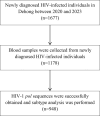Characterizing HIV-1 transmission by genetic cluster analysis among newly diagnosed patients in the China-Myanmar border region from 2020 to 2023
- PMID: 39315943
- PMCID: PMC11443545
- DOI: 10.1080/22221751.2024.2409319
Characterizing HIV-1 transmission by genetic cluster analysis among newly diagnosed patients in the China-Myanmar border region from 2020 to 2023
Abstract
Cluster analysis of HIV sequence can provide insights into viral transmission patterns in border regions. This study aims to illuminate the HIV-1 subtype distribution and transmission dynamics among newly diagnosed individuals in Dehong prefecture, a region along the China-Myanmar border. Among 948 participants with pol gene sequences, 36 HIV-1 subtypes were identified, with URFs (18.8%, 178/948) being the dominant strain, followed by CRF01_AE (18.5%, 175/948) and CRF07_BC (10.9%, 103/948). Additionally, 287 sequences (30.3%, 287/948) were grouped into 91 clusters, 31 of which contained both Chinese and Burmese individuals. Multivariable logistic regression indicated that men who have sex with men (MSM), CD4 + cell count of 200∼499, and 500 cells/μl and above, and CRF01_AE were risk factors for entering the network. Through the Chord diagram, we found frequent transmission relationships among heterosexual China male group, especially those over 35 years of age. Additionally, the correlation between heterosexual Myanmar female group and heterosexual China male group among cross-risk groups deserved to be emphasized. Furthermore, the network exhibited a growing trend over time, with the largest active transmission cluster identified in Ruili county. In conclusion, the HIV-1 subtype landscape in Dehong has become increasingly complex, and the region has faced risks of transmission from both domestic and international sources. Targeted intervention strategies should be implemented for MSM, heterosexual Chinese middle-aged and elderly men, and heterosexual Burmese young adults to mitigate these risks. These findings provided evidence-based insights for local government to formulate coordinated transnational intervention approaches.
Keywords: HIV-1; cluster analysis; cross-border; molecular epidemiology; subtype.
Conflict of interest statement
No potential conflict of interest was reported by the author(s).
Figures





Similar articles
-
Phylodynamics of HIV-1 unique recombinant forms in China-Myanmar border: implication for HIV-1 transmission to Myanmar from Dehong, China.Infect Genet Evol. 2012 Dec;12(8):1944-8. doi: 10.1016/j.meegid.2012.08.001. Epub 2012 Aug 11. Infect Genet Evol. 2012. PMID: 22917657
-
Burmese injecting drug users in Yunnan play a pivotal role in the cross-border transmission of HIV-1 in the China-Myanmar border region.Virulence. 2018;9(1):1195-1204. doi: 10.1080/21505594.2018.1496777. Virulence. 2018. PMID: 30001176 Free PMC article.
-
Diverse forms of HIV-1 among Burmese long-distance truck drivers imply their contribution to HIV-1 cross-border transmission.BMC Infect Dis. 2014 Aug 26;14:463. doi: 10.1186/1471-2334-14-463. BMC Infect Dis. 2014. PMID: 25158600 Free PMC article.
-
Subtype-specific differences in transmission cluster dynamics of HIV-1 B and CRF01_AE in New South Wales, Australia.J Int AIDS Soc. 2021 Jan;24(1):e25655. doi: 10.1002/jia2.25655. J Int AIDS Soc. 2021. PMID: 33474833 Free PMC article.
-
Understanding disclosed and cryptic HIV transmission risk via genetic analysis: what are we missing and when does it matter?Curr Opin HIV AIDS. 2019 May;14(3):205-212. doi: 10.1097/COH.0000000000000537. Curr Opin HIV AIDS. 2019. PMID: 30946142 Review.
Cited by
-
Challenges in Elucidating HIV-1 Genetic Diversity in the Middle East and North Africa: A Review Based on a Systematic Search.Viruses. 2025 Feb 27;17(3):336. doi: 10.3390/v17030336. Viruses. 2025. PMID: 40143265 Free PMC article.
References
MeSH terms
LinkOut - more resources
Full Text Sources
Other Literature Sources
Medical
Research Materials
